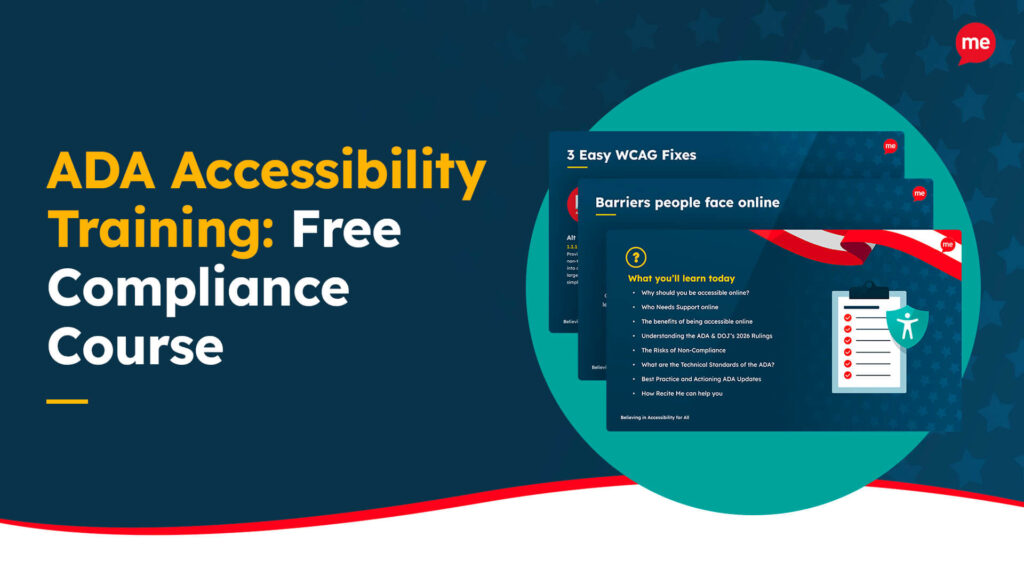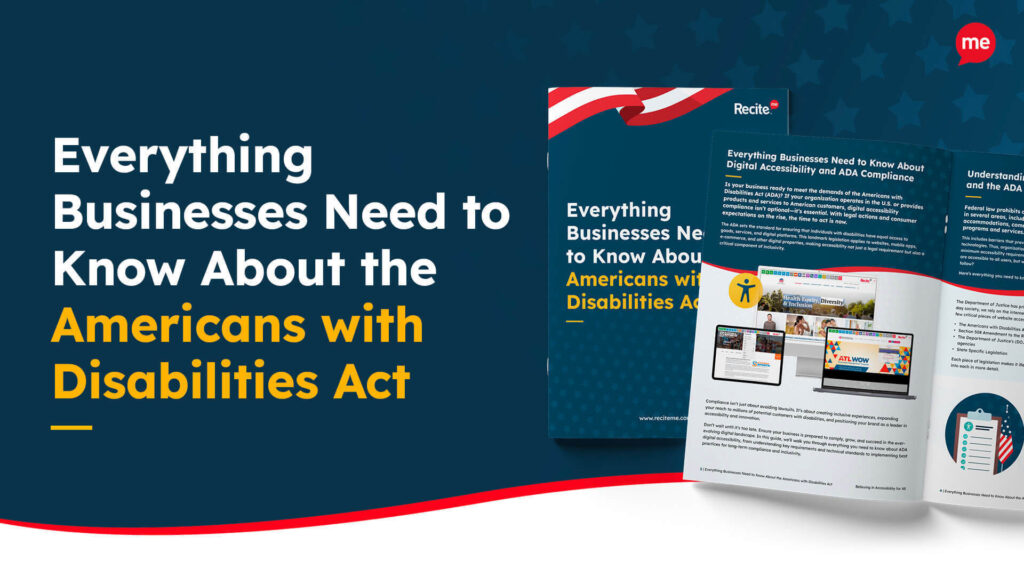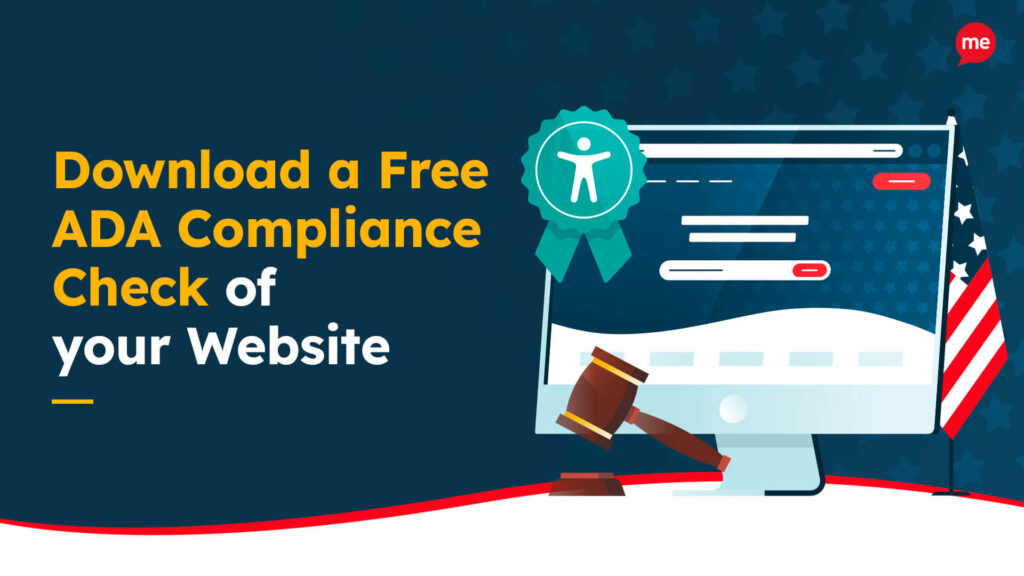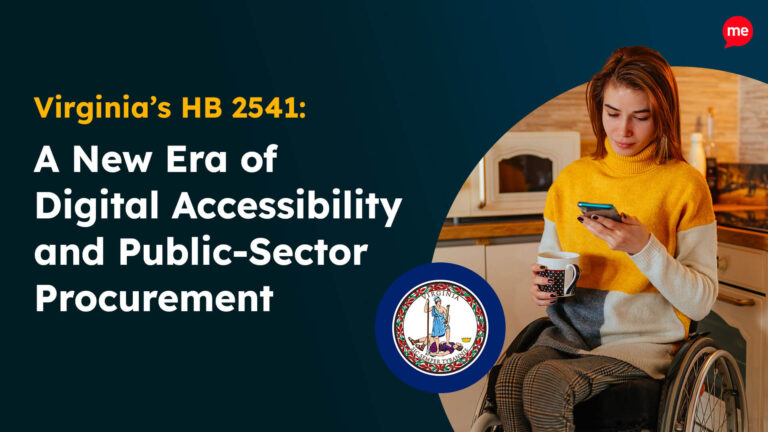Get A Free ADA Compliance Audit Of Your Website
Download NowWebsite Accessibility can be a tricky topic for business owners to grasp. But the consequences for not complying with ADA standards can be serious, with ADA lawsuits reaching a total of 4,605 cases in 2023. Emphasizing the need for this easy to follow guide to ADA Compliance Requirements for Businesses.
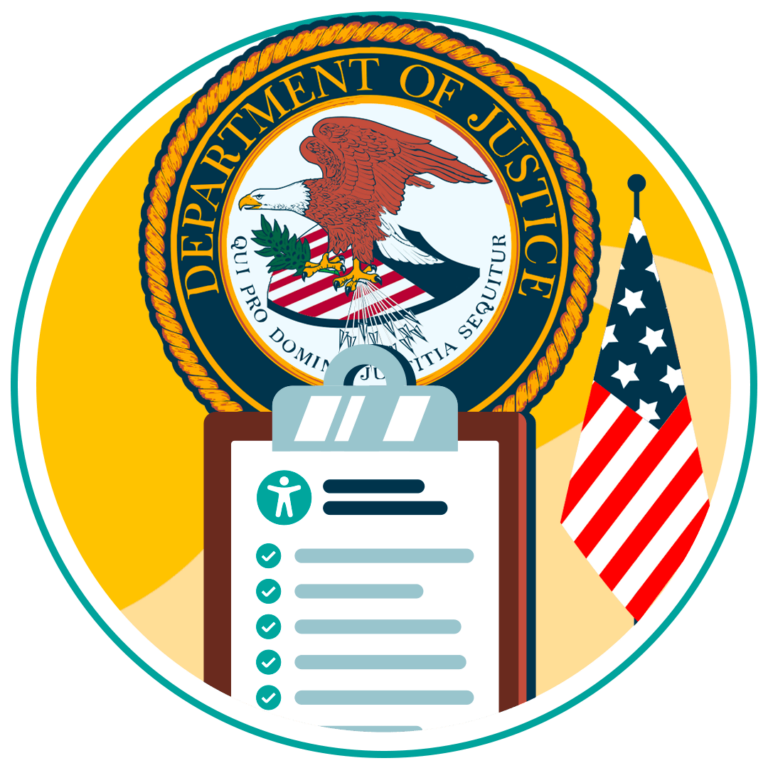
What is the American Disabilities Act?
The Americans with Disabilities Act (ADA) is a comprehensive civil rights law enacted in 1990 designed to prohibit discrimination against individuals with disabilities in various areas of public life. The ADA aims to ensure that people with disabilities have the same rights and opportunities as everyone else.
In total the ADA covers 5 key areas, these are as follows:
- Employment (Title I): This section prohibits discrimination against individuals with disabilities in all aspects of employment, including hiring, promotions, job assignments, training, benefits, and other employment-related activities. Employers with 15 or more employees must provide reasonable accommodations to qualified applicants or employees with disabilities unless doing so would cause significant difficulty or expense (undue hardship).
- Public Services (Title II): This title applies to state and local government entities, requiring them to provide equal access to programs, services, and activities. This includes public transportation and ensuring that people with disabilities can participate in and benefit from all public services offered by these entities.
- Public Accommodations (Title III): This section mandates that private businesses and nonprofit organizations that serve the public, such as restaurants, hotels, theaters, stores, doctors’ offices, private schools, and daycare centers, must be accessible to people with disabilities. This includes removing architectural barriers and providing auxiliary aids and services where necessary.
- Telecommunications (Title IV): This title requires telephone and internet companies to provide a system of telecommunications relay services (TRS) that allows individuals with hearing or speech disabilities to communicate over the telephone. It also mandates closed captioning of federally funded public service announcements.
- Miscellaneous Provisions (Title V): This title contains various provisions, including those related to insurance, retaliation, attorney’s fees, and other issues not covered in the first four titles. It also provides guidelines for the construction of accessible facilities.
Want to make sure your website is compliant with the Americans with Disabilities Act? Then unlock the ADA compliance checklist now. Discover actionable steps to ensure ADA compliance, helping you avoid lawsuits and any other negative consequences of non-compliance.
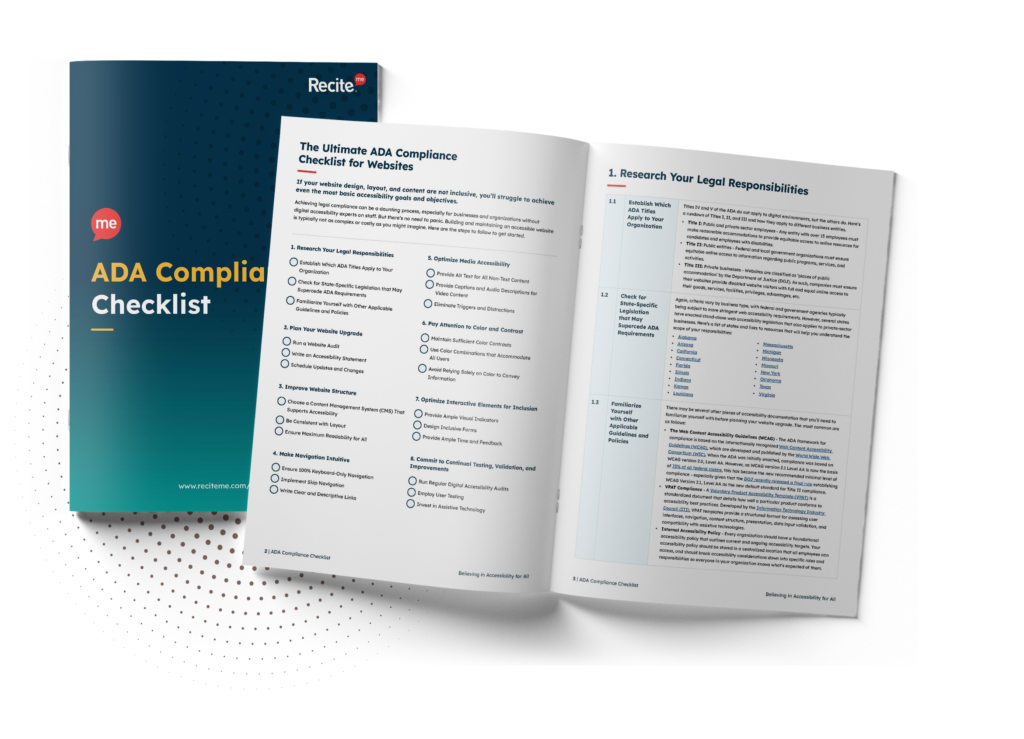
Which Businesses have to be ADA Compliant?
While ADA Compliance is highly recommended in all organizations, as it provides a wide variety of financial and non-financial benefits, it is not always mandatory. Although, in a large number of cases ADA compliance will be required for businesses where any of the following apply:
- 15 or more employees.
- Own and use commercial facilities that are open to the public. Both the landlord and tenant of commercial property must comply.
- State or local government services.
What are the ADA Requirements for Businesses?
There are a number of different ADA requirements that businesses should follow to ensure they are compliant. Some of these requirements include:


#1 Design an Accessible Website
Title III of the Americans with Disabilities Act mandates for websites to be accessible to people with disabilities. To ensure compliance with this requirement business owners should comply with the WCAG standards. WCAG has several different versions and levels, but business owners who have a website that conforms to WCAG 2.1 Level AA are unlikely to face any legal consequences.
To conform with the standards of WCAG 2.1, website owners will need to address a variety of factors, some of which include:
- Providing accessible multimedia
- Ensuring Screen Reader accessibility
- Provide good Mobile accessibility
- Keyboard Navigation
- Color contrasts that are easily visible
You can check out our ADA Compliance Website Checklist for a more complete and detailed version of the requirements and necessary steps to take for ADA Compliant Web Design.
#2 Accessible Facilities
If you are a business owner that uses commercial facilities where your customers come to visit then you’ll need to ensure you have accessible facilities. Preventing any physical accessibility barriers that may prevent people with disabilities from using your facilities is essential. Some examples of barriers include:
- No disabled parking
- Inaccessible restrooms
- Access via stairs only, no wheelchair ramps available
- Narrow aisle width
- Inaccessible signage that does not use Braille
#3 Fair Recruitment Processes with Equal Opportunities
ADA Title I has enhanced the employment opportunities for people with disabilities across the US. As employers can not reject an applicant because of a disability, everyone should be treated fairly and receive equal opportunity.
This highlights the importance of inclusive recruitment strategies in the hiring process. The following strategies can be implemented to assist with this goal:
- Inclusive job descriptions
- Accessible interviews – easy to access facilities or online interviews
- Accessible website to submit applications on and research the company culture/background
- Provide assistive technology
Ultimately, building a strong employer brand is not only important for ADA compliance but also for attracting the best talent to your business. You can check out our Inclusive Recruitment Checklist for more guidance on this topic.
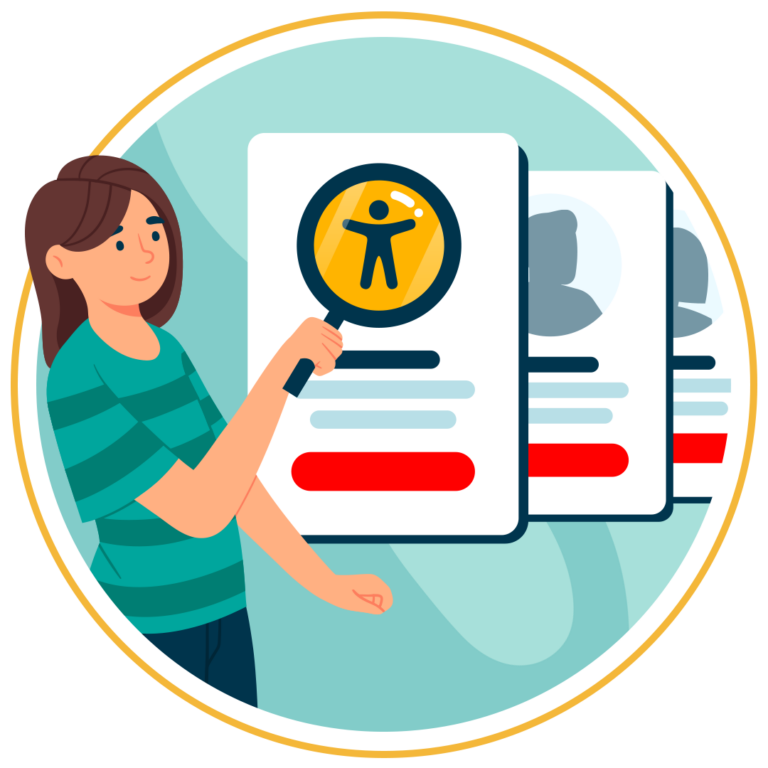
#4 Employee Training
Many businesses can overlook and underestimate the importance of training. But, a team that better understands the importance of accessibility best practices is in a better position to support disabled customers and colleagues.
Properly training employees can also mitigate against the likelihood of non-compliance. But, it’s important to update and refresh your ADA and accessibility training resources. As accessibility laws and best practices continue to change and be improved, so should the training provided.

#5 Accommodate Employees with Disabilities
Accommodating employees with disabilities is all about making reasonable adjustments to the workplace to help minimize accessibility barriers. This requirement applies to Title I of the ADA and in its simplest form helps to ensure people with disabilities have a similar experience to those without disabilities.
Some examples of reasonable adjustments business owners should make for their disabled employees include:
- Ensuring Digital Accessibility: Implementing assistive technologies such as an accessibility widget.
- Accessible Facilities: Adjusting workstations, providing accessible bathrooms or installing wheelchair access.
- Flexible working: Allowing employees to work from home when possible or adjust their work schedule.
#6 Accommodate Customers with Disabilities
Customers should be accommodated with the same degree of care as your employees to comply with ADA requirements. The Americans with Disabilities Act expects businesses to be able to communicate effectively with disabled customers.
Here are some examples of how organizations can meet these needs to satisfy customers and meet necessary ADA compliance requirements:
- Assistive Technologies to assist people with low vision: This could include Braille or Screen Readers to name just a few examples
- Assistive Technology to aid people with hearing impairments: This could include assistive listening devices, speech to text or sign language interpreters.
Get a free automated ADA compliance audit of your website. This audit will highlight compliance violations and provide the recommendations needed to meet ADA compliance standards.
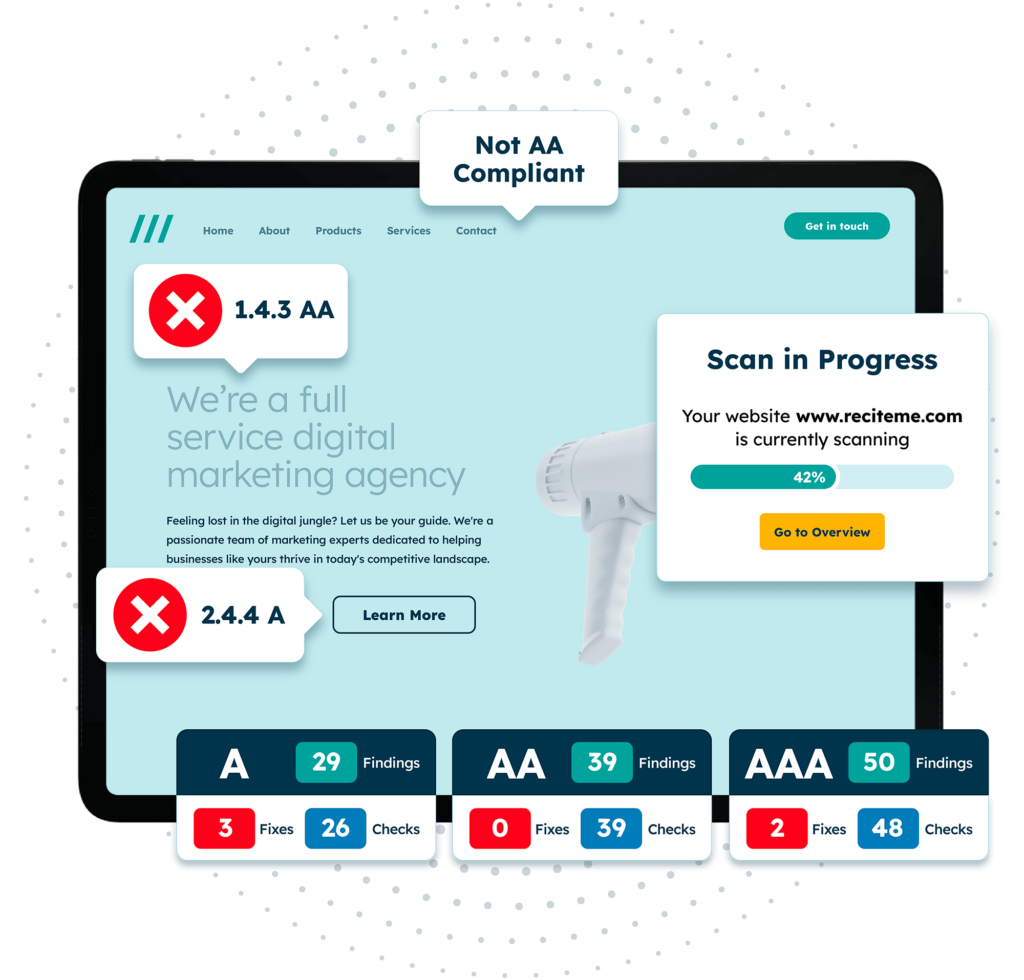
Do ADA Requirements apply to Small Businesses?
Yes, small businesses are not exempt from the ADA Compliance requirements. People with disabilities should have the same rights as all other people, the size of a business should not restrict the users rights.
The same requirements apply across the different types of businesses too. For example, a small local restaurant should provide accessible facilities that are easy to use for people with diverse disabilities.
Likewise an online business such as an eCommerce store should be accessible to its customers. Implementing accessibility best practices in regards to accessible multimedia, keyboard navigation and screen reader compatibility to name a few examples. You can learn more about ADA compliance for eCommerce websites here.
Incentives for ADA Compliance
There are a number of different incentives or benefits associated with making your business complaint with ADA requirements. These can be financial incentives, but can also provide an array of softer benefits relating to things such as brand image.
Some of the most significant benefits include:
- ADA Tax Credits: Businesses that comply with the ADA guidelines can benefit from ADA Tax Credits. This is an incentive that allows a reduction in tax for businesses that have spent money to make their organizations more ADA compliant. This can partially cover the cost of various accessibility adjustments or assistive technologies.
- Mitigate against Lawsuits: Lawsuits are only becoming more prevalent for businesses that are not willing to become ADA compliant. As such, it’s in your best interest as a business owner or senior member of staff to mitigate the likelihood of being faced with an ADA demand letter.
- Increased reach & revenue: While ADA compliance can not guarantee you a return on investment, with 1 in 4 Americans having a disability it is still a likely outcome for many organizations. By becoming ADA compliant your business will be able to access a much larger pool of potential customers.
- Brand reputation & loyalty: As Diversity and Inclusion continues to be a huge talking part in the US, there is a bigger demand placed on brands to adopt inclusive values. By becoming ADA compliant you can position your business as a responsible organization with a strong set of core values. This will enhance your brand’s reputation and consumer loyalty.

Examples of Business that have received ADA Compliance Lawsuits
Since 1990 when the Americans with Disabilities Act was first signed into law, there have been several thousand ADA compliance cases and lawsuits. With several millions worth of US dollars being awarded to plaintiffs in damages. This has affected a wide range of businesses, from multinational corporations to small state-level or local organizations.
Five Guys Burgers Vs Marett Lucia
In 2017, Five Guys Burgers and Fries received an ADA demand letter, filed by a blind person named Marett Lucia. The plaintiff alleged that the Five Guys website was inaccessible to users who experience visual impairments, noting that requirements such as alternative text for images and link headings were not met adequately.
Netflix Vs The National Association of the Deaf
In 2012, The National Association of the Deaf opened an ADA lawsuit against the streaming platform Netflix. The plaintiff alleged that Netflix had failed to provide closed captioning on much of their content, resulting in the organization’s failure to comply with ADA requirements.
The case was settled in 2013, with Netflix agreeing to pay $755,000 and captioning all of their content by 2014.
Need more help becoming ADA compliant?
The following resources are packed full of actionable tips and expert advice for making your digital content compliant with the Americans with Disabilities Act:
Free ADA Accessibility Training
Take the first step to ADA compliance by completing our training course.
Free ADA Accessibility Guide
Ensure your organization is meeting the requirements for ADA compliance.

